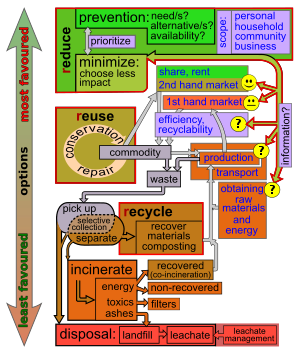
Back هرم نفايات Arabic Йерархия на отпадъците Bulgarian Affaldshierarkiet Danish Jerarquía de residuos Spanish هرم پسماند Persian מדרג הפסולת HE Hulladékhierarchia Hungarian Hierarki sampah ID Ọchịchị ndị na-emebi ihe IG Piramide dei rifiuti Italian



Waste (management) hierarchy is a tool used in the evaluation of processes that protect the environment alongside resource and energy consumption from most favourable to least favourable actions.[1] The hierarchy establishes preferred program priorities based on sustainability.[1] To be sustainable, waste management cannot be solved only with technical end-of-pipe solutions and an integrated approach is necessary.[2]
The waste management hierarchy indicates an order of preference for action to reduce and manage waste, and is usually presented diagrammatically in the form of a pyramid.[3] The hierarchy captures the progression of a material or product through successive stages of waste management, and represents the latter part of the life-cycle for each product.[3]
The aim of the waste hierarchy is to extract the maximum practical benefits from products and to generate the minimum amount of waste. The proper application of the waste hierarchy can have several benefits. It can help prevent emissions of greenhouse gases, reduce pollutants, save energy, conserve resources, create jobs and stimulate the development of green technologies.[4]
- ^ a b Hansen, Wenke; Christopher, Maria; Verbuecheln, Maic (December 2002). "EU Waste Policies and Challenges for Local and Regional Authorities" (PDF).
- ^ Environmental Protection Agency (2013). "Non-Hazardous Waste Management Hierarchy".
- ^ a b United Nations Environmental Program (2013). Guidelines for National Waste Management Strategies Moving from Challenges to Opportunities (PDF). ISBN 978-92-807-3333-4.
- ^ Waste-to-Energy Research and Technology Council (2009). "Waste Hierarchy".